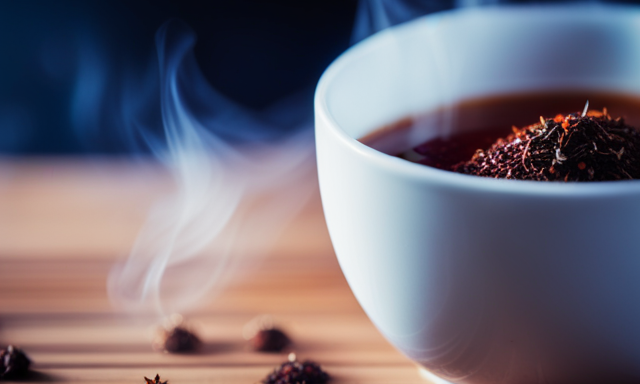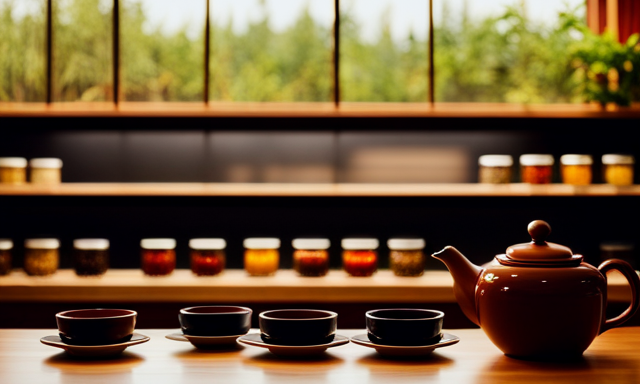Did you know that rooibos tea is one of the most popular herbal teas in the world?
With its unique flavor and impressive health benefits, it’s no wonder why people all over the globe are embracing this South African treasure.
As a tea enthusiast, I am excited to share with you everything you need to know about rooibos.
From its origins and production process to its nutritional profile and different types available, we will explore the rich and diverse world of rooibos tea.
We will also delve into its culinary uses and its potential benefits for skincare.
But it doesn’t stop there – we will also discuss the sustainability and ethical considerations surrounding the production of rooibos.
So sit back, relax, and join me on this journey as we uncover the wonders of rooibos tea.
Key Takeaways
- Rooibos tea is a caffeine-free beverage that is rich and aromatic in flavor.
- It can be brewed by steeping a tea bag in hot water for 5-6 minutes and is recommended to be served at 190°F (88°C).
- Rooibos tea can be enjoyed plain or with honey or lemon.
- Apart from being a delightful beverage, rooibos tea also has culinary uses such as being infused into desserts and used as a marinade or base for sauces in savory dishes.
Origins of Rooibos Tea
Let’s dive into the fascinating origins of rooibos tea, a beverage that’ll transport you to the sun-kissed mountains of South Africa.
The history of rooibos cultivation dates back centuries, when the indigenous Khoisan people discovered the unique properties of the Aspalathus linearis plant. This remarkable plant grows exclusively in the Cederberg region of South Africa, thriving in the sandy soil and harsh climate.
The Khoisan people traditionally harvested the leaves and stems of the plant, fermenting them to create the distinctive red color and rich flavor that we associate with rooibos tea today. Rooibos tea not only has a long history of cultivation, but it also holds great cultural significance for the people of South Africa. It’s deeply rooted in their traditions and has become a symbol of their heritage.
Now, let’s delve into the production process of rooibos, where the magic truly happens.
The Production Process of Rooibos
To make your own delicious cup of rooibos tea, you’ll start by harvesting the leaves from the Aspalathus linearis plant and then undergo a meticulous process of drying and fermentation, resulting in a rich and flavorful brew. The production of rooibos is a careful and time-consuming process, ensuring the highest quality tea. After the leaves are harvested, they are chopped and bruised to initiate the oxidation process. They are then spread out to dry in the sun, allowing enzymes to react and develop the characteristic red color and sweet aroma. Once dried, the leaves undergo fermentation, where they are moistened and left to oxidize further. This step enhances the flavor and aroma, giving rooibos its distinct taste. After fermentation, the leaves are finally sorted and packaged for distribution. Now that we’ve explored the production process, let’s delve into the health benefits of rooibos.
The Health Benefits of Rooibos
Indulging in a cup of this magical tea can work wonders for your well-being, thanks to its incredible health benefits. Research has shown that rooibos tea is packed with antioxidants, which can help protect your body against free radicals and reduce the risk of chronic diseases. It has also been found to have anti-inflammatory properties, which can help alleviate symptoms of conditions like arthritis. Additionally, rooibos tea contains several minerals, such as calcium and manganese, which are essential for maintaining healthy bones and teeth.
Moving on to the next section, let’s discuss the nutritional profile of rooibos and the impact this tea can have on your overall health.
Nutritional Profile of Rooibos
As I delve into the nutritional profile of Rooibos, I’m impressed by its rich content of vitamins and minerals. This South African herbal tea is packed with essential nutrients such as vitamin C, magnesium, and calcium. These nutrients are vital for supporting overall health and well-being.
Additionally, Rooibos is abundant in polyphenols and flavonoids, powerful antioxidants that contribute to its numerous health benefits. These benefits include reducing inflammation and protecting against chronic diseases.
Vitamins and Minerals
Rooibos tea, also known as red tea, isn’t just delicious but also packed with essential vitamins and minerals. It’s a great source of various nutrients that can contribute to overall health and well-being. Here are two sub-lists that highlight the vitamins and minerals found in rooibos tea:
Vitamins:
- Vitamin C: Rooibos tea contains a good amount of vitamin C, which’s known for its immune-boosting properties.
- Vitamin E: This vitamin acts as an antioxidant and helps protect the body against free radicals.
Minerals:
- Calcium: Rooibos tea provides a decent amount of calcium, which’s essential for strong bones and teeth.
- Magnesium: This mineral plays a vital role in maintaining healthy nerve function and muscle contraction.
These vitamins and minerals, along with the polyphenols benefits and rooibos antioxidants, make rooibos tea a nutritious beverage choice.
Moving on to the next section, let’s explore the power of polyphenols and flavonoids in rooibos tea.
Polyphenols and Flavonoids
The incredible power of polyphenols and flavonoids in this tea will leave you amazed and craving for more. Rooibos tea is packed with these antioxidants, which have numerous health benefits.
Polyphenols are known for their ability to fight against free radicals in the body, reducing the risk of chronic diseases such as heart disease and cancer. Flavonoids, on the other hand, have anti-inflammatory and immune-boosting properties. They can help improve blood circulation and lower blood pressure. These compounds also play a role in promoting healthy skin and aiding in weight management.
With all these antioxidant benefits and health effects, it’s no wonder that rooibos tea has gained popularity among health-conscious individuals.
Now, let’s explore the different types of rooibos tea and their unique characteristics.
Different Types of Rooibos Tea
When it comes to different types of Rooibos tea, there are three main varieties that stand out: Traditional Rooibos, Green Rooibos, and Flavored Rooibos Blends.
Traditional Rooibos is the classic, unflavored version of the tea, known for its earthy and slightly sweet taste.
Green Rooibos, on the other hand, is unfermented and has a lighter and more grassy flavor.
Lastly, Flavored Rooibos Blends offer a wide range of options, with added ingredients like fruits, herbs, and spices for a more diverse and unique taste experience.
Traditional Rooibos
Imagine yourself sitting in a cozy South African farmhouse, sipping on a cup of steaming hot, incredibly flavorful rooibos tea. Traditional brewing methods have been passed down through generations, preserving the cultural significance of this beloved beverage.
To prepare traditional rooibos, the leaves are harvested by hand and left to ferment in the sun until they turn a rich red color. This fermentation process is what gives rooibos its distinct flavor profile, with notes of nuttiness and sweetness. The brewed tea has a deep amber hue and a smooth, velvety texture that’s truly indulgent.
In South African households, rooibos is enjoyed throughout the day, often served with a slice of lemon or a dollop of honey.
As we delve into the next section on ‘green rooibos,’ let’s explore the fascinating journey of this tea.
Green Rooibos
Experience the refreshing and vibrant flavors of green rooibos as you immerse yourself in its naturally smooth and invigorating qualities.
Green rooibos, also known as unfermented rooibos, is made from the same plant as traditional rooibos but undergoes a different processing method. This method involves steaming the leaves immediately after they’re harvested, preventing oxidation and preserving its green color and delicate taste.
Green rooibos is packed with health benefits. It’s rich in antioxidants, which help combat free radicals and protect the body from oxidative stress. Additionally, it contains polyphenols, which’ve been linked to reducing inflammation and supporting heart health. With its naturally caffeine-free nature, green rooibos provides a soothing and calming effect, making it an excellent choice for those looking to unwind.
As we transition into the next section about flavored rooibos blends, you’ll discover how green rooibos serves as a perfect base for a variety of exciting and delicious flavor combinations.
Flavored Rooibos Blends
Indulge in the exquisite taste and aromatic blends of flavored rooibos, elevating your tea-drinking experience to new heights. Flavored rooibos recipes offer a delightful twist on traditional rooibos tea, infusing it with a variety of flavors that tantalize the taste buds. Whether you prefer fruity and refreshing blends like strawberry or peach, or more indulgent flavors like chocolate or caramel, there is a flavored rooibos blend to suit every palate. These popular flavored rooibos blends are carefully crafted to balance the natural sweetness of rooibos with complementary flavors, resulting in a harmonious and satisfying cup of tea.
Try a variety of flavored rooibos blends to discover your favorite, and experiment with different brewing techniques to enhance the flavors even further. In the next section, we will explore the art of brewing and serving rooibos tea, ensuring you enjoy every sip of this remarkable beverage.
Brewing and Serving Rooibos Tea
To brew and serve rooibos tea, start by steeping a tea bag in hot water for 5-6 minutes. This allows the flavors to infuse, resulting in a rich and aromatic cup of tea. Rooibos tea is caffeine-free, making it a perfect choice for those seeking a soothing and relaxing beverage.
When it comes to brewing techniques, it’s important to use hot, but not boiling water. The recommended serving temperature for rooibos tea is around 190°F (88°C). This ensures that the tea is brewed properly and maintains its distinct flavors.
Once brewed, you can enjoy rooibos tea as is or add honey or lemon for a touch of sweetness or acidity.
Now, let’s explore the culinary uses of rooibos and discover its versatility in the kitchen.
Culinary Uses of Rooibos
When it comes to culinary uses, rooibos is a versatile ingredient that can be used in a variety of ways. One delicious way to incorporate rooibos is by infusing it into desserts, such as cakes, cookies, and ice creams, to add a unique and flavorful twist.
Additionally, rooibos can also be used in savory dishes, like marinades for meats or as a base for sauces, to enhance the taste and bring a hint of sweetness to the dish.
The possibilities are endless when it comes to cooking with rooibos, making it a must-have ingredient for any adventurous chef.
Rooibos Infused Desserts
Imagine yourself biting into a creamy rooibos-infused cheesecake, the rich flavors of the tea mingling perfectly with the smooth texture of the dessert. Rooibos, with its distinct earthy taste, isn’t just a popular choice for beverages but also makes a delightful addition to desserts.
From rooibos-infused cocktails to rooibos-infused ice cream, there are endless possibilities to satisfy your sweet tooth. The natural sweetness of rooibos adds depth and complexity to dishes, creating a unique flavor profile that’s both comforting and indulgent.
Whether it’s a rooibos-infused panna cotta or a decadent rooibos chocolate mousse, these desserts are sure to impress.
Now, let’s delve into the world of rooibos in savory dishes…
Rooibos in Savory Dishes
Indulge in the tantalizing flavors of a rooibos-infused stew, where the earthy notes of the tea blend harmoniously with savory spices and tender meat.
Rooibos isn’t just limited to desserts; it can also be a star ingredient in savory dishes. Adding rooibos to soups creates a rich, aromatic base that enhances the overall flavor profile. The earthiness of the tea adds depth and complexity, while its natural sweetness balances out any acidity.
The versatility of rooibos extends beyond soups; it can be used as a marinade for meats, infusing them with a unique and delightful taste. The tea’s subtle smokiness and herbal undertones elevate the flavors, resulting in a truly memorable dish.
As we delve into the benefits of rooibos tea for skincare, you’ll discover even more reasons to incorporate this remarkable ingredient into your daily routine.
Rooibos Tea and Skincare
Using rooibos tea in skincare routines can provide numerous benefits for your skin, such as reducing inflammation and promoting a healthy, radiant complexion. Rooibos tea is packed with antioxidants that help protect the skin from damage caused by free radicals, which can accelerate the aging process. It also contains alpha hydroxy acid, which gently exfoliates the skin, removing dead cells and promoting cell turnover for a smoother, more even complexion. Additionally, rooibos tea has anti-inflammatory properties that can soothe irritated skin and reduce redness. To incorporate rooibos tea into your skincare routine, you can try using it as a toner, mixing it with other natural ingredients for a homemade face mask, or even adding it to your bath water for a relaxing and rejuvenating soak. By incorporating rooibos tea into your skincare routine, you can enjoy its many benefits and achieve healthier, more radiant skin. Speaking of sustainability and ethical considerations…
Sustainability and Ethical Considerations
When it comes to sustainability and ethical considerations surrounding rooibos tea, there are two key points to consider: Fair Trade and Organic Certification, as well as supporting rooibos farmers.
Fair Trade ensures that farmers are paid a fair price for their product and that ethical labor practices are followed. Organic Certification guarantees that the tea is produced without the use of harmful chemicals.
By supporting rooibos farmers, we contribute to their livelihoods and help promote sustainable farming practices.
Fair Trade and Organic Certification
If you think Fair Trade and Organic Certification are just trendy buzzwords, you must not know the true value and impact they have on the production of rooibos tea. These certifications ensure that rooibos farmers are treated fairly and that the tea is grown using sustainable and environmentally friendly practices.
Here are three reasons why Fair Trade and Organic Certification are crucial for the production of rooibos:
-
Fair trade benefits: Fair trade ensures that farmers receive fair prices for their products, allowing them to support their families and invest in their communities. It also promotes gender equality and empowers farmers to have a voice in the global market.
-
Organic farming practices: Organic certification guarantees that no harmful chemicals or pesticides are used in the cultivation of rooibos. This not only protects the health of the farmers and consumers but also preserves the biodiversity of the region.
-
Environmental sustainability: By following organic farming practices, rooibos farmers contribute to the preservation of the delicate ecosystems in which the tea is grown. This helps to maintain the biodiversity of the region and protect the natural resources for future generations.
Understanding the significance of Fair Trade and Organic Certification is essential in supporting rooibos farmers and ensuring the sustainability of this beloved tea.
Supporting Rooibos Farmers
Now that we have discussed the importance of Fair Trade and Organic Certification in the rooibos industry, let’s explore how we can further support the rooibos farmers. By supporting fair trade practices, we not only ensure that the farmers receive fair wages for their hard work, but also contribute to the economic development of their communities. This is especially important as the rooibos industry is a significant source of income for many farmers in South Africa. When we choose to purchase fair trade certified rooibos tea, we are making a conscious decision to promote sustainability and ethical practices.
To illustrate the impact of our support, let’s take a look at the following table:
| Fair Trade Practices | Economic Impact |
|---|---|
| Ensures fair wages for farmers | Creates job opportunities |
| Supports community development | Encourages sustainable agriculture |
| Promotes ethical practices | Fosters economic growth |
By understanding the positive effects of our choices, we can continue to support the rooibos farmers and their communities. Now, let’s dive into the world of rooibos tea and explore its rich flavors and health benefits.
Exploring the World of Rooibos Tea
Discover the rich and flavorful world of rooibos tea, and indulge in its unique taste and health benefits. Rooibos tea isn’t just delicious, but it also offers numerous health benefits. It’s rich in antioxidants, which help fight free radicals and reduce the risk of chronic diseases. Additionally, rooibos tea is caffeine-free, making it a great alternative for those looking to reduce their caffeine intake.
When it comes to brewing techniques, rooibos tea can be enjoyed hot or cold. For a hot cup of rooibos tea, simply steep the tea bag in boiling water for about 5 minutes. If you prefer an iced version, steep the tea bag in hot water for the same amount of time, then pour the tea over ice and enjoy. Rooibos tea can also be flavored with a variety of ingredients, such as lemon, honey, or cinnamon, to enhance its taste and aroma.
Overall, exploring the world of rooibos tea is a delightful journey that offers both taste and health benefits. So go ahead, try a cup and savor the goodness of this unique beverage.
Frequently Asked Questions
How long has rooibos tea been consumed?
Rooibos tea has been consumed for centuries, originating from South Africa. It gained popularity in the 20th century and has become a staple for its numerous health benefits and unique flavor profile.
Can rooibos tea be enjoyed hot and cold?
Yes, rooibos tea can be enjoyed both hot and cold. It’s a versatile beverage that offers numerous health benefits. Whether I want a comforting hot cup or a refreshing iced drink, rooibos always hits the spot.
Are there any side effects or potential risks associated with consuming rooibos tea?
There’s no denying the allure of rooibos tea, but it’s important to be aware of potential risks. While it offers numerous health benefits, excessive consumption may lead to liver problems or interfere with certain medications.
Can rooibos tea be consumed during pregnancy or while breastfeeding?
During pregnancy or while breastfeeding, it is generally safe to consume rooibos tea. There are no safety concerns associated with it, making it a good alternative option for those looking for a caffeine-free beverage.
Are there any restrictions or recommendations for the storage of rooibos tea to maintain its freshness and flavor?
To maintain the freshness and flavor of rooibos tea, storage recommendations include keeping it in an airtight container away from light, heat, and moisture. This helps preserve its delicate taste and aroma for a longer period of time.
Conclusion
In conclusion, as I delve deeper into the world of Rooibos tea, I’m reminded of a beautiful sunset over the African savannah. Just like the vibrant colors that paint the sky, Rooibos tea offers a delightful burst of flavor and a myriad of health benefits.
With its rich history, sustainable production methods, and versatile uses, Rooibos is truly a gem worth exploring. So, next time you sip on a cup of this exquisite tea, remember the sunset and let it transport you to the enchanting lands where Rooibos originates.










